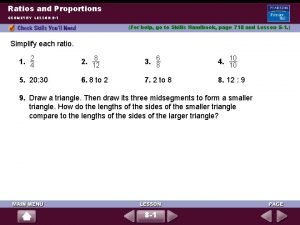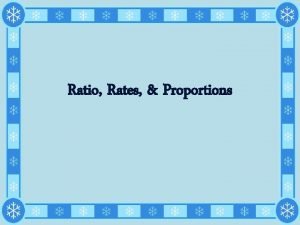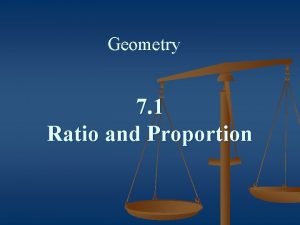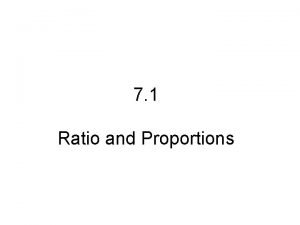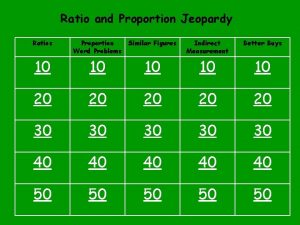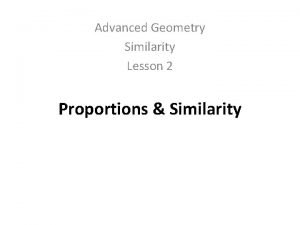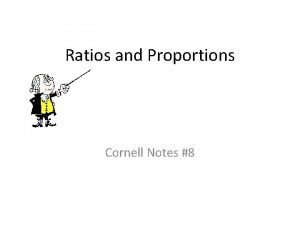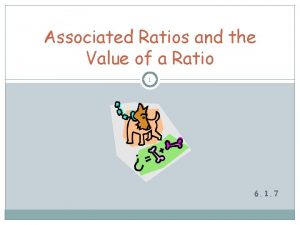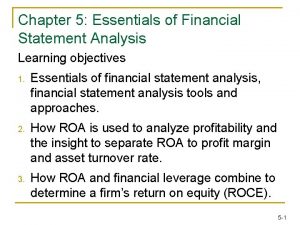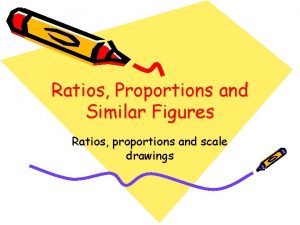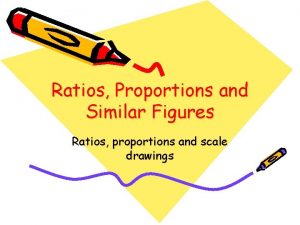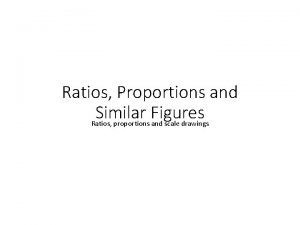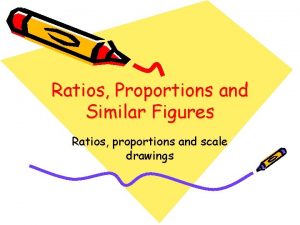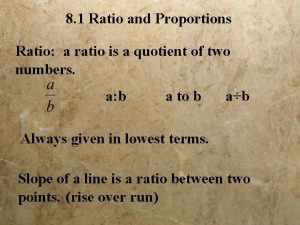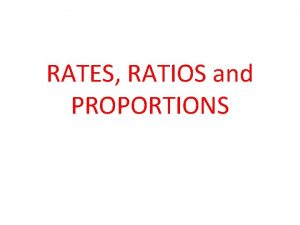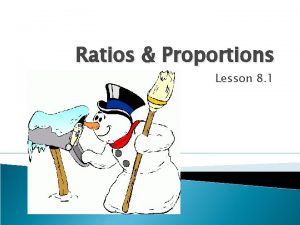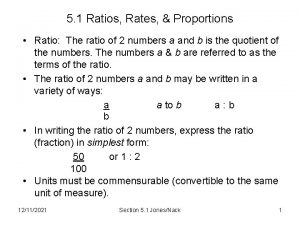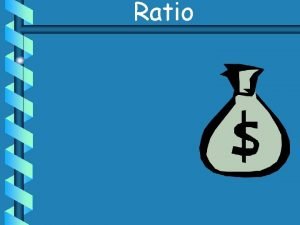PRESENTATION 9 Ratios and Proportions RATIOS A ratio




















- Slides: 20

PRESENTATION 9 Ratios and Proportions

RATIOS • A ratio is the comparison of two like quantities • • The terms of a ratio must be compared in the order in which they are given Terms must be expressed in the same units The first term is the numerator of a fraction, and the second term is the denominator A ratio should be expressed in lowest fractional terms

RATIOS • Ratios are expressed in two ways: • • With a colon between the terms, such as 4: 9 • This is read as “ 4 to 9” With a division sign separating the two numbers, such as 4 ÷ 9 or

RATIOS • Example: Express 5 to 15 as a ratio in lowest terms • Write the ratio as a fraction and reduce • The ratio is 1 : 3

RATIOS • Example: Express 10 to in lowest terms • Divide • The ratio is 12 : 1 as a ratio

PROPORTIONS • A proportion is an expression that states the equality of two ratios • Proportions are expressed in two ways • • As 3 : 4 = 6 : 8, which is read as “ 3 is to 4 as 6 is to 8” As , which is the equation form

PROPORTIONS • A proportion consists of four terms • • The first and fourth terms are called extremes The second and third terms are called means In the proportion 3 : 4 = 6 : 8, 3 and 8 are the extremes and 4 and 6 are the means The product of the means equals the product of the extremes (if the terms are cross-multiplied, their products are equal)

PROPORTIONS • Example: Solve the proportion below for F: • Cross multiply: 21. 7 F = 6. 2(9. 8) • Divide both sides by 21. 7: • Therefore F = 2. 8

DIRECT PROPORTIONS • • Two quantities are directly proportional if a change in one produces a change in the other in the same direction When setting up a direct proportion in fractional form: • • Numerator of the first ratio must correspond to the numerator of the second ratio Denominator of the first ratio must correspond to the denominator of the second ratio

DIRECT PROPORTIONS • Example: A machine produces 280 pieces in 3. 5 hours. How long does it take to produce 720 pieces? • • Analyze: An increase in the number of pieces produced (from 280 to 720) requires an increase in time Time increases as production increases; therefore, the proportion is direct

DIRECT PROPORTIONS • • • Set up the proportion and let t represent the time required to produce 720 pieces The numerator of the first ratio corresponds to the numerator of the second ratio (280 pieces to 3. 5 hours) The denominator of the first ratio corresponds to the denominator of the second ratio (720 pieces to t)

DIRECT PROPORTIONS • Solve for t: • It will take 9 hours to produce 720 pieces

INVERSE PROPORTIONS • Two quantities are inversely or indirectly proportional if a change in one produces a change in the other in the opposite direction • Two quantities are inversely proportional if • • An increase in one produces a decrease in the other A decrease in one produces an increase in the other

INVERSE PROPORTIONS • When setting up an inverse proportion in fractional form: • • The numerator of the first ratio must correspond to the denominator of the second ratio The denominator of the first ratio must correspond to the numerator of the second ratio

INVERSE PROPORTIONS • Example: Five identical machines produce the same parts at the same rate. The 5 machines complete the required number of parts in 1. 8 hours. How many hours does it take 3 machines to produce the same number of parts? • • Analyze: A decrease in the number of machines (from 5 to 3) requires an increase in time Time increases as the number of machines decrease and this is an inverse proportion

INVERSE PROPORTIONS • • • Let x represent the time required by 3 machines to produce the parts The numerator of the first ratio corresponds to the denominator of the second ratio; 5 machines corresponds to 1. 8 hours The denominator of the first ratio corresponds to the numerator of the second ratio; 3 machines corresponds to x

INVERSE PROPORTIONS • Solve for x: • It will take 3 hours

PRACTICAL PROBLEMS • A piece of lumber 2. 8 meters long weighs 24. 5 kilograms • A piece 0. 8 meters long is cut from the 2. 8 -meter length • Determine the weight of the 0. 8 meter piece

PRACTICAL PROBLEMS • Analyze: Since the weight of 0. 8 meters is less than the total weight of the piece of lumber, this is a direct proportion • Set up the proportion and let x represent the weight of the 0. 8 -meter piece

PRACTICAL PROBLEMS • Solve for x: • The piece of lumber weighs 7 kilograms
 If abcd is a rectangle and m adb=55 what is the value of x
If abcd is a rectangle and m adb=55 what is the value of x Ratios, rates, and proportions
Ratios, rates, and proportions 7-1 ratios and proportions
7-1 ratios and proportions 7-1 ratios and proportions
7-1 ratios and proportions 4-1 lesson quiz
4-1 lesson quiz Proportion examples
Proportion examples Ratios and proportions jeopardy 7th grade
Ratios and proportions jeopardy 7th grade Rates ratios and proportions
Rates ratios and proportions Ratios and proportions geometry
Ratios and proportions geometry 7-1 ratios & proportions
7-1 ratios & proportions 2-6 ratios and proportions
2-6 ratios and proportions Unit 6 homework 1 ratio proportion answer key
Unit 6 homework 1 ratio proportion answer key Notes on proportions
Notes on proportions Equivalent ratios
Equivalent ratios 2-6 ratios and proportions
2-6 ratios and proportions 1-8 rates ratios and proportions
1-8 rates ratios and proportions Proportions warm up
Proportions warm up Alyssa's extended family is staying at the lake house
Alyssa's extended family is staying at the lake house Acid test ratio and quick ratio
Acid test ratio and quick ratio Phenotypic ratio of dihybrid cross
Phenotypic ratio of dihybrid cross Current ratio and quick ratio
Current ratio and quick ratio
